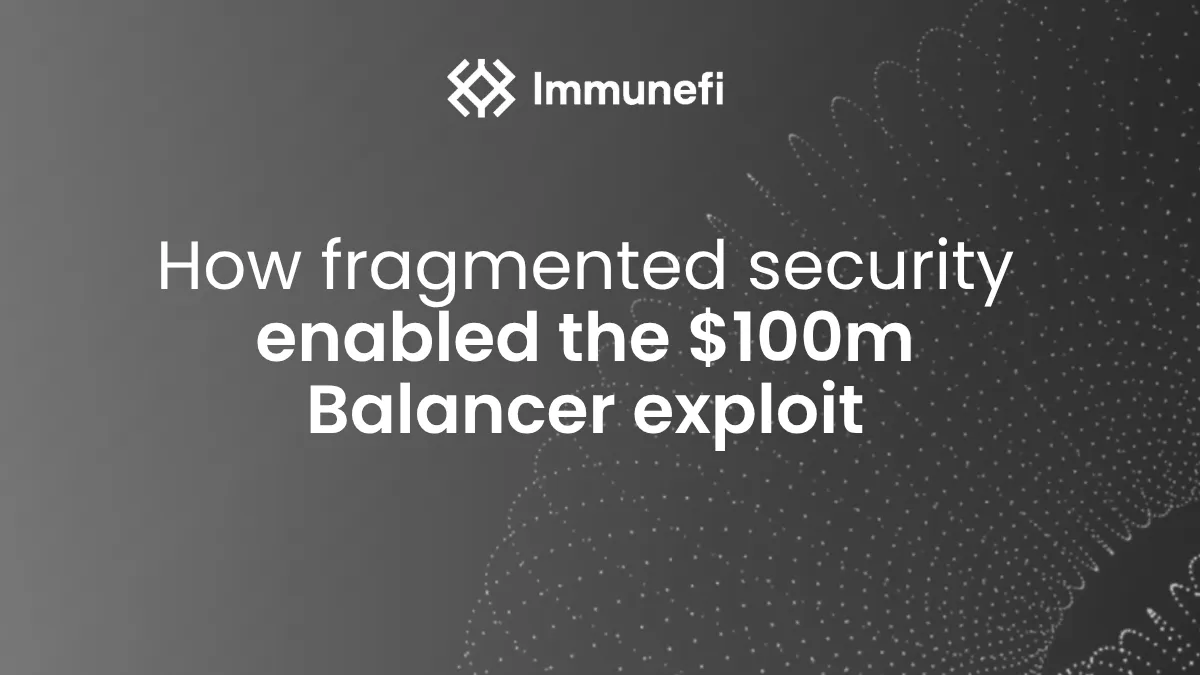How fragmented security enabled the $100m Balancer exploit

In November 2025, Balancer was exploited for over $100 million through a precision-loss bug in composable stable pools. This isn't a coding blunder on Balancer's end, but a coordinated failure stemming from security controls that don't work together, a major problem for all protocols, not just Balancer.
The issue combined rounding behavior in scaled token math with specific swap sequences that amplified tiny accounting discrepancies into real value extraction. It was not a simple coding mistake. It was a subtle interaction in pool accounting that conventional reviews were not designed to detect at scale.
The incident showed how strong individual controls can still fail when they operate in isolation.
This pattern extends across DeFi. The ecosystem has capable teams and mature tools, but limited integration between them. Audits, bug bounties, and monitoring all add value, yet the space between them remains exposed.
Immunefi is building a unified platform to close that gap. By linking prevention, intelligence, and response into a continuous system, Immunefi enables protection that is coordinated, data-informed, and always active.
What made the Balancer exploit possible?
Understanding what made the Balancer exploit possible requires looking beyond the headline number.
This wasn't a single bug, but several conditions aligning at once. Examining those conditions clarifies why fragmented security leaves protocols exposed, and why unified defense is becoming essential:
Delayed containment
Balancer’s internal balance mechanism allows accounting without on-chain ERC-20 transfers during complex batches.
The attacker used sequences that included flash-minted BPT and carefully chosen swaps to push raw balances of pool tokens into ranges where precision loss is maximized. This setup stage did not realize profit on its own; it prepared the pool for the precision-loss loop.
A rounding error that cascaded
The root cause of this exploit was in Balancer’s composable stable pool design, which supports related assets via scaling factors stored at 1e18 precision. When very small raw amounts are scaled and divided, integer division introduces precision loss. Under normal conditions this is negligible.
The attacker orchestrated swaps to make pool raw balances small and then exploited the rounding-down effect repeatedly, turning tiny imbalances into extractable value.
The structural takeaway
No single factor explains this exploit. Design assumptions about scaled math, reliance on internal balances, and operational constraints on pausing combined to create an opening.
This is a systemic lesson. Onchain security can't rely on sequential or disconnected controls. To prevent compound failures like this, the system must integrate design, verification, monitoring, and response into a unified defense that shares visibility and context across every layer.
Closing the gaps in onchain defense
Immunefi’s platform is designed to connect what, in most protocols, still operates in isolation: audits, monitoring, bug bounties, threat intelligence, and incident response. By unifying these solutions, it helps teams move from fragmented protection to a coordinated posture that continuously improves.
Rather than predicting every exploit, the goal is to make it far more difficult, by design, for small oversights like those seen in the Balancer case to turn into systemic failure. The platform creates a shared environment where visibility, communication, and incentives reinforce one another, reducing the risk that any single gap escalates unchecked.
In 2023, a security researcher disclosed a rounding-error issue in Balancer’s ERC4626 Linear Pools combined with flash swap via Immunefi, which Balancer mitigated. A member of the Balancer team has since noted that the 2025 incident is related in pattern but not the same, and that the affected pool type differs from the 2023 case. The connection is instructive: vulnerability classes can recur across pool designs, and abstracting them into detection rules is a practical way to harden posture over time.
Immunefi’s Professional Services and platform enable protocols to manage critical controls, from pausing and governance actions to response readiness, under a unified operational standard.
Coordinated visibility
Immunefi Magnus integrates intelligence, vulnerability data, and onchain monitoring into a single operational view. Teams see, in real time, how contract changes, new integrations, or governance actions alter risk, and how vulnerabilities, assets, and dependencies connect.
Continuous intelligence
Drawing on Immunefi’s network of security researchers and its dataset of verified onchain exploits and bug reports, the platform surfaces emerging attack patterns and technical behaviors before they spread. Lessons from one incident strengthen defenses for many.
Unified response
When an incident occurs, the platform enables faster coordination between monitoring partners, protocol operators, and Immunefi responders. In timing-sensitive situations, that speed reduces losses. Processes that once depended on manual communication and ad hoc escalation can be coordinated within minutes.
Beyond coordination, Immunefi’s incident response capabilities give protocols structured containment playbooks and access to expert responders who operate around the clock. This ensures that operational execution matches the speed of technical detection.
Aligned incentives
Security improves when every participant has a reason to maintain it. Through Immunefi’s incentive structures, researchers, protocols, and communities benefit from continuous protection. This turns security from a one-time cost into a shared, ongoing objective.
Together, these systems create a feedback loop where every incident improves collective defense. Information from past exploits strengthens detection. Coordinated response data refines preventive controls. Over time, the network becomes more resilient against complex, multi-layer threats.
Making security continuous and connected
DeFi security has matured around a wide set of specialized tools. Audits verify contract logic, bug bounties crowdsource testing, and monitoring tools detect anomalies in real time. Each delivers value on its own, but without a shared framework to connect them, they operate as parallel efforts rather than parts of a single system.
The result is a form of protection that is strong in pieces but inconsistent in practice. Insights from one process rarely reach the next. Vulnerability data collected through a bounty program might never inform monitoring rules. Audit findings may not translate into real-time detection logic. Valuable knowledge is created across the ecosystem every day, yet much of it remains isolated.
A unified platform transforms those independent efforts into an integrated architecture. Immunefi Magnus is designed to connect prevention, intelligence, and response within one operational layer, creating continuous feedback between them. Each function strengthens the others. Detection feeds back into design. Bounty intelligence informs runtime monitoring. Response data improves future prevention.
This shift from discrete tools to cohesive systems will define the next phase of onchain security. Protection can no longer depend on periodic review or manual coordination. It must evolve into a live process that learns, adapts, and responds as one.
Immunefi Magnus is built for that purpose. It provides the command structure needed to make DeFi security continuous, connected, and resilient at scale.
Building a future without systemic onchain exploits
The Balancer exploit was not an outlier. It showed how complexity can outpace coordination, even for established and well-secured protocols.
As onchain systems grow larger and more composable, that challenge becomes universal. The question is no longer whether individual tools can perform their roles, but whether the entire security stack can operate as one.
Immunefi’s unified platform is designed to meet that need. By connecting prevention, intelligence, and response within a single command center, it turns security from a reactive process into an active discipline. Protocols gain continuous visibility into exposure, faster access to ecosystem intelligence, and structured coordination when incidents occur.
Unified security doesn’t replace audits, bug bounties, or monitoring. It connects them. In doing so, it turns separate point solutions into a living system of protection that evolves with the networks it secures.
If you're ready to discover the future of onchain security, get started with Immunefi today.



